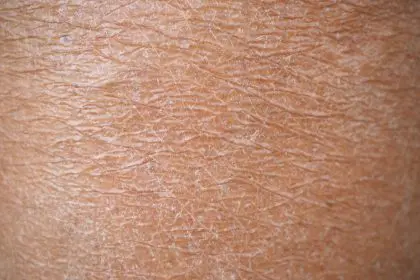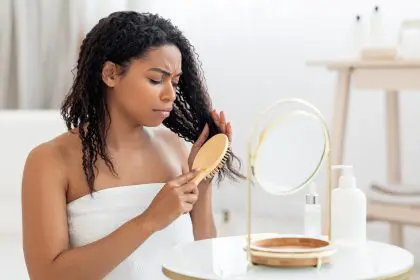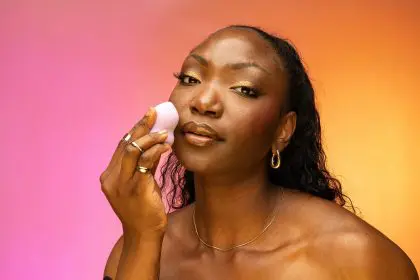Your reflection stares back from the mirror, and all you can see are what appear to be craters scattered across your face. Those pores that once seemed manageable now look like they could swallow entire makeup brushes, and no amount of foundation seems capable of creating the smooth, poreless complexion you desperately crave.
The frustrating truth is that your enlarged pores might not be a genetic curse or an inevitable consequence of aging. Instead, they could be the direct result of a single, devastating mistake that millions of people make every single day without realizing the damage they’re causing to their skin.
This mistake is so deeply ingrained in modern skincare culture that it’s often celebrated as good hygiene and dedicated self-care. Beauty enthusiasts praise those who commit this error, viewing their extreme approach as evidence of commitment to skincare excellence. Meanwhile, their pores continue to stretch and become more visible with each passing day.
The irony is that this mistake often stems from genuinely good intentions. People who fall into this trap are usually the most dedicated to achieving beautiful skin, the most willing to invest time and money in their skincare routines, and the most frustrated when their efforts seem to backfire spectacularly.
The over-cleansing catastrophe that’s destroying your skin
The mistake that’s making your pores look dramatically larger is aggressive over-cleansing combined with the use of harsh, stripping skincare products that obliterate your skin’s natural protective barrier. This seemingly innocent error creates a cascade of damage that makes pores appear more prominent and noticeable than they would naturally.
Over-cleansing involves using cleansers that are too harsh, cleansing too frequently, or combining multiple cleansing steps that strip away the skin’s natural oils and protective elements. Many people believe that squeaky-clean skin is healthy skin, but this couldn’t be further from the truth.
When you aggressively strip away your skin’s natural oils and protective barrier, your sebaceous glands panic and begin producing excessive amounts of oil to compensate for what’s been removed. This overproduction of sebum leads to enlarged pores as the glands work overtime to replace the moisture and protection that’s been aggressively removed.
The damaged skin barrier also becomes more susceptible to environmental damage, inflammation, and bacterial overgrowth, all of which contribute to pore enlargement and a rougher skin texture that makes pores appear even more prominent.
Why harsh cleansers are your pores’ worst enemy
Harsh cleansers containing sulfates, high concentrations of acids, or abrasive particles create microscopic damage to the skin’s surface that makes pores appear larger and more visible. These aggressive ingredients strip away not just dirt and oil, but also the beneficial lipids and proteins that keep skin smooth and healthy.
The skin’s natural acid mantle, a protective film with a slightly acidic pH, gets disrupted by harsh cleansers that are too alkaline. This disruption compromises the skin’s ability to defend itself against bacteria and environmental stressors, leading to inflammation that can make pores appear more prominent.
Sulfate-based cleansers, commonly found in foaming face washes, are particularly damaging because they’re designed to remove oil completely. While this might feel satisfying in the moment, it triggers a rebound effect where oil production increases dramatically to compensate for the aggressive stripping.
Physical scrubs and cleansing brushes used too frequently or with too much pressure can cause micro-tears in the skin and chronic low-level inflammation that makes pores appear larger and more noticeable over time.
The double-cleansing trap that’s backfiring
The popular double-cleansing method, when taken to extremes, can become another version of this pore-enlarging mistake. While gentle double-cleansing can be beneficial for removing makeup and sunscreen, aggressive double-cleansing with harsh products compounds the damage to your skin barrier.
Using an oil cleanser followed by a harsh foaming cleanser essentially strips the skin twice, removing not just makeup and impurities but also the beneficial oils and lipids that keep skin healthy and pores tight. This double assault on the skin barrier triggers the same overproduction of oil that makes pores appear larger.
Many people compound this error by following their double cleanse with toners, serums, or treatments that contain high concentrations of acids or other active ingredients, essentially triple or quadruple-processing their skin every single day.
The cumulative effect of this excessive cleansing routine is chronically compromised skin that’s constantly trying to repair itself while being subjected to daily damage, creating the perfect conditions for enlarged, more visible pores.
How damaged skin barriers make pores look huge
A healthy skin barrier is smooth, plump, and well-hydrated, which helps minimize the appearance of pores by creating an even surface texture. When this barrier is compromised through over-cleansing, the skin becomes dehydrated, rough, and uneven, making pores appear dramatically larger.
Dehydrated skin lacks the plumpness that helps pores appear smaller and less noticeable. When skin cells shrink due to moisture loss, they create tiny valleys around pores that cast shadows and make the pores appear deeper and more prominent.
The inflammation caused by barrier damage also contributes to pore enlargement as inflamed skin becomes thicker and more textured, emphasizing rather than minimizing pore visibility. This chronic inflammation can also lead to the breakdown of collagen and elastin around pores, causing them to lose their structural support and appear larger.
Compromised skin barriers also have difficulty regulating oil production effectively, leading to the clogged pores and blackheads that make pores appear even more prominent and unsightly.
The sebaceous gland panic response
When you strip your skin’s natural oils through aggressive cleansing, your sebaceous glands interpret this as an emergency situation requiring immediate action. These glands, which are connected to your hair follicles and pores, begin producing oil at an accelerated rate to replace what’s been removed.
This overproduction of sebum not only makes your skin feel oily and look shiny, but it also stretches the pores as they work to accommodate the increased oil flow. Over time, this stretching becomes more permanent, leaving you with visibly enlarged pores even when oil production eventually normalizes.
The panic response also affects oil quality, often producing sebum that’s thicker and more likely to clog pores, creating blackheads and whiteheads that make pores appear even larger and more noticeable.
This vicious cycle continues as long as you maintain aggressive cleansing habits, with each day of over-cleansing triggering another round of sebaceous gland panic and subsequent pore stretching.
The pH disruption disaster
Healthy skin maintains a slightly acidic pH between 4.5 and 5.5, which helps preserve the skin barrier and keep beneficial bacteria in balance. Many harsh cleansers have an alkaline pH that disrupts this delicate balance and contributes to pore enlargement.
When skin pH becomes too alkaline, the proteins that help maintain skin structure become damaged, leading to a breakdown in the skin’s ability to maintain tight, small-appearing pores. The alkaline environment also promotes the growth of harmful bacteria that can cause inflammation and make pores appear larger.
The disrupted pH also affects enzyme function in the skin, impairing the natural exfoliation process that helps keep pores clear and minimizes their appearance. Without proper enzyme function, dead skin cells accumulate around pores, making them appear larger and more clogged.
Restoring proper skin pH through gentle cleansing and appropriate skincare products is essential for minimizing pore appearance and maintaining healthy skin barrier function.
Why your skin is rebelling against perfection
The pursuit of perfectly clean, pristine skin often backfires because skin health depends on maintaining a delicate balance of oils, beneficial bacteria, and protective elements. When you aggressively remove everything from your skin’s surface, you’re essentially destroying the ecosystem that keeps skin healthy and pores minimized.
Your skin needs some oil to function properly, maintain flexibility, and protect against environmental damage. When you strip away all oil through harsh cleansing, you’re forcing your skin into survival mode, which prioritizes oil production over pore tightness and smooth texture.
The beneficial bacteria that live on healthy skin also play a role in maintaining skin balance and preventing the overgrowth of harmful bacteria that can contribute to pore enlargement. Aggressive cleansing disrupts this bacterial balance, often leading to skin problems that make pores more prominent.
Perfect cleanliness isn’t actually healthy for skin, and the pursuit of it often creates the very problems you’re trying to avoid, including enlarged pores, increased oiliness, and compromised skin texture.
The morning cleansing mistake
Many people compound their over-cleansing error by cleansing their skin just as aggressively in the morning as they do at night, even though morning skin hasn’t been exposed to makeup, sunscreen, or environmental pollutants overnight.
Morning over-cleansing is particularly damaging because it removes the beneficial oils and repair compounds that your skin produces overnight during its natural regeneration process. This morning oil strip-down sets you up for a full day of compromised skin barrier function and reactive oil production.
Your skin works hard overnight to repair damage and restore balance, producing protective oils and compounds that help maintain healthy pore appearance. Aggressive morning cleansing undoes this overnight repair work and triggers another cycle of sebaceous gland panic.
A gentle morning cleanse with lukewarm water or a very mild cleanser is often sufficient to prepare skin for the day without triggering the damage cascade that leads to enlarged pores.
The active ingredient overload
The over-cleansing mistake often extends beyond cleansers to include excessive use of active ingredients like acids, retinoids, and exfoliating treatments that can contribute to barrier damage and pore enlargement when used incorrectly or too frequently.
Layering multiple active ingredients or using them too frequently can create chronic irritation and inflammation that makes pores appear larger and more prominent. The skin becomes stuck in a constant state of damage and repair, never achieving the calm, balanced state that promotes tight, minimized pores.
The temptation to use every active ingredient available often leads to a skincare routine that’s too aggressive for the skin to handle, resulting in the opposite of the desired effect: larger-looking pores, increased oil production, and compromised skin texture.
Finding the right balance of active ingredients and allowing adequate recovery time between treatments is essential for maintaining healthy skin barrier function and minimized pore appearance.
The solution: gentle cleansing for smaller-looking pores
The path to smaller-looking pores lies in gentle cleansing that removes impurities without stripping away the skin’s natural protective elements. This means choosing mild, pH-balanced cleansers that clean effectively without causing damage or triggering sebaceous gland panic.
Look for cleansers with a creamy or lotion-like texture rather than harsh foaming formulas, and avoid products containing sulfates, high concentrations of acids, or abrasive particles that can damage the skin barrier.
Cleanse only once or twice daily using lukewarm water and gentle, circular motions without excessive pressure or scrubbing. Pat skin dry with a clean towel rather than rubbing, and immediately follow with appropriate moisturizer to support barrier repair.
Consider incorporating barrier-repairing ingredients like ceramides, niacinamide, and hyaluronic acid into your routine to help restore damaged skin and minimize pore appearance over time.
Patience and consistency for long-term results
Reversing the damage caused by over-cleansing and restoring smaller-looking pores takes time and consistent gentle care. Your skin needs weeks or even months to repair barrier damage and rebalance oil production, so patience is essential for seeing results.
Consistency with gentle cleansing practices is more important than using expensive products or complex routines. Simple, gentle care performed consistently will yield better results than aggressive treatments that continue to damage the skin barrier.
Track your progress through photos rather than daily mirror examination, as improvements in pore appearance happen gradually and can be difficult to notice day by day.
Remember that genetics, age, and sun damage also influence pore size, so while gentle cleansing can significantly improve pore appearance, some degree of visible pores is normal and healthy.
The mistake of over-cleansing is one of the most common yet overlooked causes of enlarged-looking pores, but it’s also one of the most correctable through simple changes in cleansing habits and product choices.











